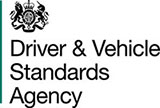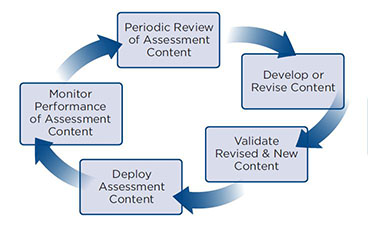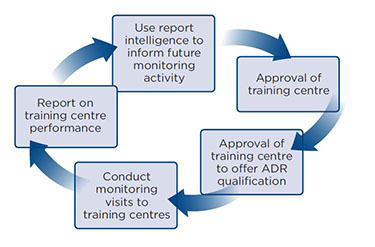Dangerous Goods Driver Training Scheme (ADR)
 Management of the UK Government's Dangerous Goods Driver Scheme (ADR) by SQA has delivered a number of features and benefits. The scheme has evolved to develop and maintain the currency of driver competences and assessments, while the introduction of new technologies has enhanced the experience of training providers and drivers. As a result, Government, businesses and individuals can have confidence in the standards of training and assessment, contributing to the safe transportation of dangerous goods.
Management of the UK Government's Dangerous Goods Driver Scheme (ADR) by SQA has delivered a number of features and benefits. The scheme has evolved to develop and maintain the currency of driver competences and assessments, while the introduction of new technologies has enhanced the experience of training providers and drivers. As a result, Government, businesses and individuals can have confidence in the standards of training and assessment, contributing to the safe transportation of dangerous goods.
The challenge
The European Community Directive 94/55/EC requires drivers of vehicles containing dangerous goods to hold an ADR Driver Training Certificate. In 2006, the UK Department for Transport (DfT) awarded SQA the contract to manage the Dangerous Goods Driver Training Scheme. This involved managing the transition from the previous scheme, demonstrating continuous compliance with the ADR Directive, and delivering uninterrupted services.
The DfT Driver and Vehicle Standards Agency is responsible for the safe transportation of dangerous goods in the UK, and is accountable to the United Nations Economic Commission for Europe (UNECE) for ensuring compliance with the Directive. It is enforceable by law through the UK Carriage of Dangerous Goods and Transportable Pressure Equipment Regulations.

The approach
SQA project-managed the development of the scheme, co-ordinating the output of representatives from the DfT, other regulatory bodies and a group of experts representing the industry drawn from trade associations, training providers, major employers and sector skills councils.
Purpose: to deliver a consistently high level of classroom and practical training to all classes of drivers transporting dangerous goods that sits within a quality assurance system that ensures all drivers of dangerous goods are trained, assessed and certificated to the same high standard.
Output: drivers who meet this standard and keep it up to date are issued with an ADR Vocational Training Certificate.
Innovation
SQA introduced new technologies in order to enhance alignment of the training and assessment to the EC Directive.
- Bureaucracy was streamlined in 2006 through the introduction of a web-based system for managing approvals and monitoring training provision, assessment and certification of drivers.
- A major review of competences, syllabus and assessments was conducted in 2008 by a group of industry stakeholders. SQA provided an analysis of the current scheme against the ADR Directive and proposed a new structure for the syllabus and assessments. This was accepted by the DfT, and has been implemented.
- In 2012, a plastic photo identification card replaced the paper certificate in response to the new ADR Directive. Previously, SQA had transferred data to the UK road licensing authority to issue the paper ADR certificate. The new system allows SQA to produce the card and issue it directly to candidates.

SQA’s assessment development model is used to develop and validate assessments on the ADR syllabus.
The assessment development model is a continuous cycle of:
- Developing or revising content
- Validating revised and new content
- Deploying assessment content
- Monitoring the performance of assessment content
- Periodic review of assessment content
The quality assurance model ensures that training standards are maintained and improved.

SQA's quality assurance model can be summarised as:
- Approval of training centre
- Approval of training centre to offer ADR qualification
- Conduct monitoring visits to training centres
- Report on training centre performance
- Use report intelligence to inform future monitoring activity
Our assessment delivery model offers drivers access to assessments:
- Register candidates
- Issue identification key
- Schedule test
- Undertake test
- Issue results and certificate via photo identity card
Benefits
- Department for Transport has the reassurance that training, assessment and certification is to the required standard and that the scheme is compliant with the ADR EC Directive.
- Drivers are consistently trained and assessed to a high standard.
- Employers are able to train and assess all drivers against a set standard.
- Training centres work to a clear syllabus and assessment process with robust ADR accreditation.
- Industry enjoys improved reputation by professionalising the occupation through the integrity of the scheme and maintaining high standards in training and safety.
Educational advisor to the Department for Transport
SQA has provided advice and support to the DfT on the rules and regulations governing training and assessment of drivers of goods vehicles. For example, changes to the ADR EC Directive can occur every two years and we have commented on potential changes and how these might impact on the regulation of the scheme for the safe transportation of goods in the UK. In addition, SQA has represented the DfT at the United Nations Economic Commission for Europe, Dangerous Goods Working Party meetings in France and Spain in recent years.
How the ADR works
- SQA approves all activity within the scheme — training centres, trainers, assessors
- SQA provides the ADR syllabus to training providers
- SQA provides the ADR Manual of Practice outlining the rules and regulations of the scheme
- Training centres carry out the training to approved standards
- SQA sets external assessments which training centres invigilate
- SQA’s External Verifiers audit, monitor and report on training activities
- SQA issues the ADR Driver Training Certificate using the photo identification card
- ADR is enforced through UK regulatory authorities at the roadside
For more information on the ADR, visit the Dangerous Goods Driver Training (DGDT) website.
Related Information
Contact Information
Start your journey with SQA.
Thinking of offering an SQA qualification?
Get in touch to discuss your next steps and find out more.
